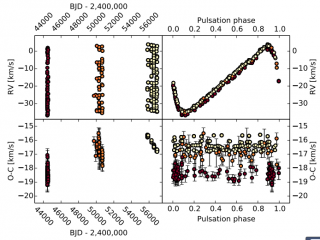 Classical Cepheid variable stars are crucial calibrators of the cosmic distance scale thanks to a relation between their pulsation periods and luminosities. Their archetype, δ Cephei, is an important calibrator for this relation. In this paper, we show that δ Cephei is a spectroscopic binary based on newly-obtained highprecision radial velocities. We combine these new data with literature data to determine the orbit, which has period 2201 days, semi-amplitude 1.5 km s−1 , and high eccentricity (e = 0.647). We re-analyze Hipparcos intermediate astrometric data to measure δ Cephei’s parallax ($ = 4.09 ± 0.16 mas) and find tentative evidence for an orbital signature, although we cannot claim detection. We estimate that Gaia will fully determine the astrometric orbit. Using the available information from spectroscopy, velocimetry, astrometry, and Geneva stellar evolution models (MδCep ∼ 5.0 − 5.25 M ), we constrain the companion mass to within 0.2 < M2 < 1.2 M . We discuss the potential of ongoing and previous interactions between the companion and δ Cephei near pericenter passage, informing reported observations of circumstellar material and bow-shock. The orbit may have undergone significant changes due to a Kozai-Lidov mechanism driven by the outer (visual and astrometric) companion HD 213307. Our discovery of δ Cephei’s nature as a spectroscopic binary exposes a hidden companion and reveals a rich and dynamical history of the archetype of classical Cepheid variables.
Classical Cepheid variable stars are crucial calibrators of the cosmic distance scale thanks to a relation between their pulsation periods and luminosities. Their archetype, δ Cephei, is an important calibrator for this relation. In this paper, we show that δ Cephei is a spectroscopic binary based on newly-obtained highprecision radial velocities. We combine these new data with literature data to determine the orbit, which has period 2201 days, semi-amplitude 1.5 km s−1 , and high eccentricity (e = 0.647). We re-analyze Hipparcos intermediate astrometric data to measure δ Cephei’s parallax ($ = 4.09 ± 0.16 mas) and find tentative evidence for an orbital signature, although we cannot claim detection. We estimate that Gaia will fully determine the astrometric orbit. Using the available information from spectroscopy, velocimetry, astrometry, and Geneva stellar evolution models (MδCep ∼ 5.0 − 5.25 M ), we constrain the companion mass to within 0.2 < M2 < 1.2 M . We discuss the potential of ongoing and previous interactions between the companion and δ Cephei near pericenter passage, informing reported observations of circumstellar material and bow-shock. The orbit may have undergone significant changes due to a Kozai-Lidov mechanism driven by the outer (visual and astrometric) companion HD 213307. Our discovery of δ Cephei’s nature as a spectroscopic binary exposes a hidden companion and reveals a rich and dynamical history of the archetype of classical Cepheid variables.
Authors: Richard I. Anderson, Johannes Sahlmann, Berry Holl, Laurent Eyer, Lovro Palaversa, Nami Mowlavi, Maria Süveges, Maroussia Roelens

